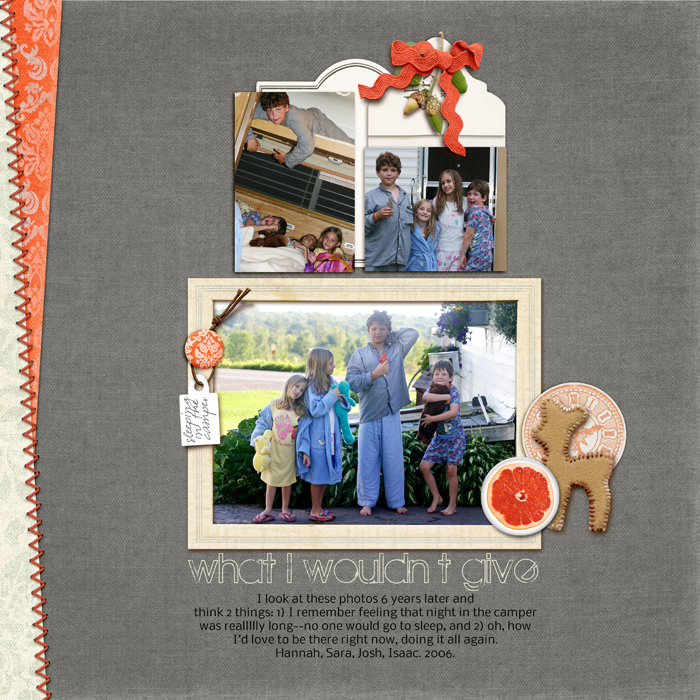by Debbie Hodge
When you’re scrapbooking photos of people, you’ve got an opportunity to document and show more than is immediately obvious. The things the people in your photos are doing and how they’re doing them, what they say and how they say it, and even the items they’re holding or using or wearing may all point to more about their personality and contribute to a portrait that goes beyond the obvious.
Try these three approaches to scrapbooking portraits.
1. The Mug Shot
Scrapbook a “portrait” photo with details about your subject right now: age, date, interests, and preferences can all add up to one vivid in-the-moment portrait. Use colors, styling, and motifs that support your portrait.
On “Now You Are Six,” Melanie Grimes captures details about her daughter on her birthday: how she likes parties and jewelry and hairbands as well as what she likes to eat, how her friendships are, and even that her teachers adore her.
Now You are Six by Melanie Grimes | Supplies: Katie Pertiet - Watery Banners No 1, stamping strips love No. 01, Journal strips No. 01, polka dotty alpha, Black tab alpha, filed journaling labels neutral, aged strips alpha, Lynn Grieveson - Stormy weather Kit, font marydale.
Emily Pitts has used this photo of her son with his chin up and looking off — as into the future — to create a portrait of him at 13, on his way to becoming a man.
Boy at 13 by Emily Pitts | Supplies: Patterned papers: Simple Stories and My Mind’s Eye. Alphabet: Girls’ Paperie. kraft envelope, wooden rulers, chipboard frame, wooden bingo number, kraft clock, star pin: Maya Road. Twine: The Twinery. Pen: Marvy. Thread: Coats and Clark. Adhesive: Xyron, Scotch.
2. Action is Character
If Aristotle is right and “action is character,” then a look at what your subjects do and the choices they make is a great place to start to make pages that show who the people on your pages really are. When you’ve got photos from an outing, event, or everyday situation that you’d like to scrap, begin by asking what is/are your subject(s) doing. Connect this obvious action to what it says about the character or personality of your subject(s), including what it might say about attitudes, approaches, and just a general way of being.
Betsy Sammarco‘s “1 Reason” includes duplicates of the same photo: a photo of her husband with their dog. She used this photo of him and the way he is here as an opportunitiy to talk about how he had a dog when she met him, and that the way he took care of the dog was one of the reasons she began to love him.
One Reason by Betsy Sammarco | Supplies: Autumn Leaves Die Cut Daisy, Heidi Swapp Chipboard letters, Hamby Studios rub-ons, Jenni Bowlin Studio embellished butterfly, mini ric rac
My husband is so very disciplined and so very in love with riding his bike. Every year he sets a mileage goal, and when the good weather stretches into late fall, he’s especially happy. I made an effort to be out waiting for him on a November evening when he came home to get these shots that show his persistence.
Fall Riding by Debbie Hodge | Supplies: Krafty Cuts Leaves No 1, Krafty Canvas No 1, Fall Fun Element Pack, Banner Saftey Tags No 1, Scallop Strip Masks, Lifted Leaves No 1 by Katie Pertiet; Folded Ribbon Bits by Pattie Knox; Autumn Moon Ephemera by Sahlin Studio; Journey Back Elements by Vinnie Pearce; Wild Weekend, To The Woods, Glitter Thread Stitches by Lynn Grieveson; Westover by One Little Bird; Fall and Halloween Handdrawn words by Ali Edwards
3. Curating Artifacts
Look to the items in your photos–clothes, toys, tools, trinkets–and think about what they reveal about your subject that may not be obvious from the photo alone. As in the allegorical paintings you might have studied in art history, these artifacts often function as a metaphor or symbol for something more, perhaps a preoccupation, a style, or a need.
I recently pulled up this old photo of my sons, and immediately noticed that Isaac had a stuffed animal in his arms and Joshua had . . . something that looked like a squirt gun. I asked him what it was, and even though it’s six years later, he immediately knew it was a cap gun. In the smaller photo, he’s holding a terra cotta warrior in his hands. He’s always done this — posed for photos with treasures presented, as if these treasures (which equate to his interests) are important to a portrait of him. And Isaac? Isaac has been a cuddly kid who loved soft and cute things from his earliest days.
What I Wouldn't Give by Debbie Hodge | Supplies: Darling Dear Kit by Creashens; File Box 3 by Paula Kesselring; Pull-out Journaling by Lynn Grieveson; The Daily Details by Digi Chick Collaborative; The Maple Origins, Nobile fonts.
When Betsy Sammarco saw her son’s prayer card so full of tic marks, she knew what he was praying for and what it meant. She used the actual prayer card with photos of her son to tell this powerful story of him, his faith, and his love for her.
Go through your photos and find some portraits that you can take beyond what shows up in the photo.







